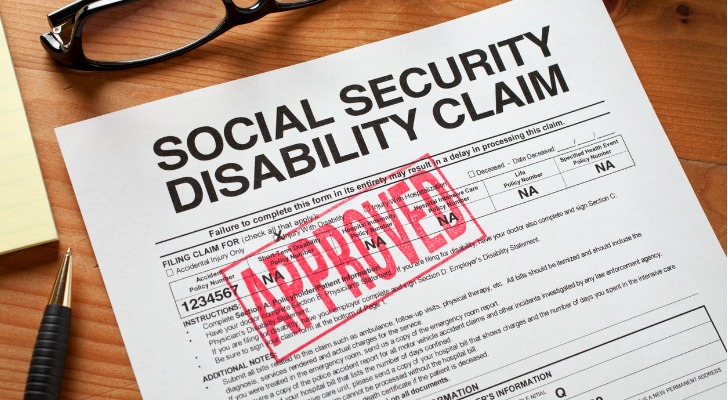

Social Security Disability Insurance (SSDI) is a federal program that provides cash assistance to workers who are disabled, either emotionally or physically, or blind but have contributed enough to the Social Security trust fund to qualify. You’ll need a set amount of work history to qualify, and the amount depends upon your age.
Consider working with a financial advisor as you prepare for retirement.
For workers under 24, the program requires at least 1.5 years of contribution during the three years prior to the disability. For workers over 30, that threshold is five years during the prior 10. If you’re age 24 through 30, you need to have worked at least half of the time between your 21st birthday and the quarter during which you became disabled. In addition to your recent work history, the SSA looks at your total career, requiring a total contribution duration between 1.5 and 9.5 years depending on your age.
If you’re still able to work with your disability, you may still be eligible for SSDI, but your income must be below the program’s limit after you’ve deducted any disability-related expenses. This limit is also known as the threshold for Substantial Gainful Activity (SGA).
While the SSDI program doesn’t limit you in terms of unearned income or assets, it does have rules regarding wages earned through work. If you’re not careful, you can risk losing your eligibility. To avoid that, get to know the Social Security Disability income limits.
While SSDI is valuable to many, applicants need to carefully consider the program before applying. The maximum disability you can receive in 2024 is $3,822 per month (up from $3,627 in 2023). However, the average recipient likely received an amount of around $1,537 per month (up from $1,483 in 2023). That might not be financially adequate for you, especially considering the income limits in place.
Here’s how they work:
In 2023, disabled workers received an average monthly benefit from Social Security of around $1,483. While that can help supplement a household’s income, it’s not enough on its own. Alone, that level of benefit barely keeps an individual above the 2024 annual poverty guideline at $15,060 ($14,580 in 2023).
As a result, many individuals try to supplement their income while collecting disability benefits. They may do so through passive income, like investing, an inheritance or earned income. However, substantial gainful activity (SGA) is any work exceeding the disability income limit. If you engage in SGA, then you could potentially risk losing your benefits. So, it’s important to keep tabs on your income while on disability or applying for it.
The rules regarding SGA change depending on your disability status, though. SGA applies to both SSI benefits and Social Security for non-blind disabled individuals. For people in this group, the 2024 SGA amount is $1,550 ($1,470 in 2023). In contrast, it only affects Social Security for the blind. Individuals in this category have an SGA amount of $2,590 ($2,460 in 2023).
You may want to integrate back into the workforce at some point. It’s possible to do so. For anyone already receiving benefits who wants to try working again, you can enroll in a trial work period (TWP).
This period spans nine months, during which you have no income limit. Therefore, you can still collect monthly benefits and won’t face SGA consequences. This work should not conflict with the type of disability you have, though. For example, if you began collecting disability benefits due to a bodily injury, you should not perform a physically demanding job. Doing so may call into question your need for Social Security.
The trial period doesn’t have to be nine consecutive months in a row. Instead, SSDI recipients can opt for a 60-month rolling period. If you decide that the work is not possible after all, then you can stop and continue receiving benefits. A month gets counted into this trial period if you earn over a certain amount. For 2024, that requires the SSDI recipient to earn more than $1,110 (up from $1,050 in 2023).
If the recipient works the entire trial period and makes more than $1,110 each month, the SSA evaluates the individual. Any working over the SGA amount will enter a three-month grace period. They can continue to collect benefits during that time, after which it stops.
Additionally, earning more than your SGA amount will likely trigger a trial work period.

Some recipients may fall into another category. They earn over the $1,150 threshold during their trial period, but under the SGA amount of $1,550 for non-blind individuals (up from $1,470 in 2023). Under these circumstances, people can qualify for an extended period of eligibility. It takes place after your trial period end and lasts for 36 months. During the extended period of eligibility, you can still receive SSDI benefits. However, you only receive them in months you earn below the SSDI income limits.
Then, your benefits end after the 36-month mark, and you consistently earn more than the SSDI limit. You can reapply for benefits, though. If you find yourself unable to work at some point in the following five years, you can get re-approved. This is known as an Expedited Reinstatement (EXR) of Benefits. So, your benefits and approval kick back in much more quickly than the first time.
There are a few factors that Social Security looks at to determine your eligibility for disability benefits.
First, you must have held a job that Social Security covers. Essentially, that means you pay into Social Security, either through self-employment taxes or directly from your payroll. According to the Social Security Administration’s data, 89% of working U.S. citizens between the ages of 21 and 64 meet this qualification. While you do that, you earn Social Security work credits which help you qualify for disability benefits.
The amount you need to earn for a work credit varies between years. For 2024, you can earn one credit per $1,730 in income (up from $1,640 in 2023). Earning $6,920 in wages or self-employment income earns you four credits in total – the maximum available annually.
The overall number of work credits you need to qualify, then, depends on your age. Younger workers generally need less than their older counterparts. The rules generally follow this pattern:
The SSA has a table with estimates for both age and years of work that you can review here. Remember, earning credits must be done within a certain amount of time.
In addition, you must also have a medical condition that fits the definition of disability used by Social Security. They generally look at five conditions to determine this:
As a result, Social Security does not offer disability benefits to anyone with a partial or short-term disability. Only those with a total disability qualify.
There are some special situations, though, where the individual may not exactly fit these conditions. They include blind or low-vision individuals, disabled children, wounded warriors & veterans and widows/widowers.
People who are considering applying or currently receiving benefits may feel like they have to walk a tightrope to stay on it. In particular, they can face strict rules if they are presently employed or wish to work part-time. So, you must understand what you need to do to ensure you can keep collecting SSDI benefits.
You may experience changes during your enrollment. For example, you may move, pick up a part-time job or even become a parent. It’s your responsibility to report any events that could impact your eligibility to the SSA. You should make your report as soon as possible, but no later than 10 days after the month when the change happened. You can read a fuller list of reporting responsibilities in this publication.
You also want to stay on top of your condition, benefits and earnings. Continue to visit your doctor so that you have proof of an enduring disability. And keep track of your income to ensure you don’t exceed the monthly limits. If, at one point, your benefits stop, you have the right to request an appeal. Once you receive notice of the SSA’s decision, you must repeal it within 60 days. You can submit evidence and an appeal online through the SSA’s website, download the appeal forms, or contact your local Social Security office and they’ll send the forms along to you.

SSDI is a vital, although modest, source of financial support for disabled individuals. And over 183 million workers in Social Security-covered jobs have access to it as a result of their taxes. However, the income limits in place can make it difficult to navigate or support yourself financially when facing the rising cost of living. Due to this, and the approval requirements, it might be wise to consult a financial advisor. They can help you strategize and organize your finances. That way, you remain qualified for the program but learn ways to boost your financial independence.
Photo credit: ©iStock.com/KLH49, ©iStock.com/KLH49, ©iStock.com/RelaxFoto.de
Ashley KilroyAshley Kilroy is an experienced financial writer currently serving as an investment and insurance expert at SmartAsset. In addition to being a contributing writer at SmartAsset, she writes for solo entrepreneurs as well as for Fortune 500 companies. Ashley is a finance graduate of the University of Cincinnati. When she isn’t helping people understand their finances, you may find Ashley cage diving with great whites or on safari in South Africa.
Read More About Retirement



More from SmartAsset
SmartAsset Advisors, LLC ("SmartAsset"), a wholly owned subsidiary of Financial Insight Technology, is registered with the U.S. Securities and Exchange Commission as an investment adviser. SmartAsset's services are limited to referring users to third party advisers registered or chartered as fiduciaries ("Adviser(s)") with a regulatory body in the United States that have elected to participate in our matching platform based on information gathered from users through our online questionnaire. SmartAsset receives compensation from Advisers for our services. SmartAsset does not review the ongoing performance of any Adviser, participate in the management of any user's account by an Adviser or provide advice regarding specific investments.
We do not manage client funds or hold custody of assets, we help users connect with relevant financial advisors.
This is not an offer to buy or sell any security or interest. All investing involves risk, including loss of principal. Working with an adviser may come with potential downsides such as payment of fees (which will reduce returns). There are no guarantees that working with an adviser will yield positive returns. The existence of a fiduciary duty does not prevent the rise of potential conflicts of interest.